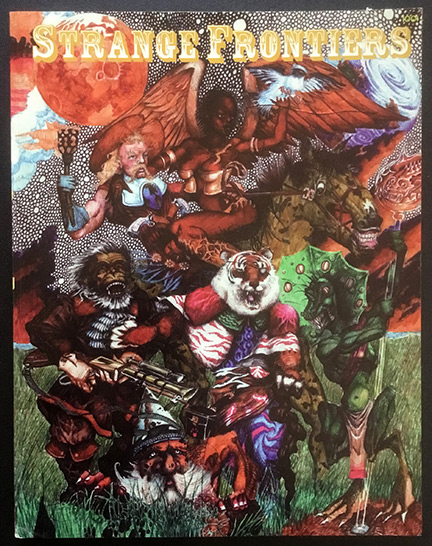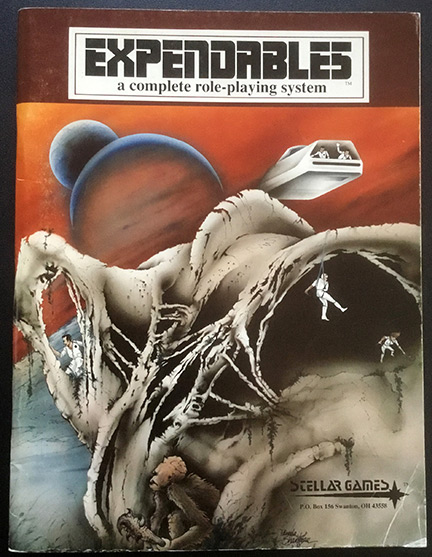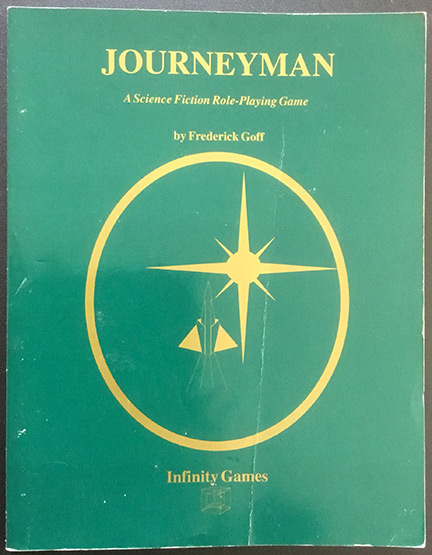|
 |
|
This is part 2 in a series discussing forgotten RPGs (Part 1 can be found here). That is, games most people have never heard of or that didn't last long on store shelves for one reason or another. This batch consists of science fiction games. These games have been sitting on my shelf for years, mostly ebay finds to add to my collection.


1. Space Infantry (by Daniel Douglass Hutto; published by D&R Game Design in 1982)

From what I can tell, there were multiple add-ons for this game, but I only have the original rules book. This is a small, 70-page digest-sized book utilized 6 and 10-sided dice. There is no setting, just the rules. Characters consist of 6 qualities, ranging from 1-20 (though most start at 1-10): intelligence, agility, speed, strength, constitution, and charm. The odd thing is that the book says that charm is not very important for game purposes, but players are always concerned with their characters' looks. That's fine, but at least try to work it in the game somehow. So level increases are basically increases in rank, which provide new benefits. Characters start as cadets. The typical space combat skills are included, but it looks like each character only gets one, which becomes his specialty. Combat is handled by rolling a cross-referenced percentage from both opponents' agility rating. Other factors, like injury, can alter this percentage. Other maneuvers can be performed at a percentage determined on charts by the character's agility or strength ratings. Ship combat is more involved, but similar in design. There's basic rules for creating aliens (which are handled like other games' monsters). There's not much art, but the ship designs are pretty good. All in all, a very good game for its time and the original price ($8), but lacking in the content of other contemporary games like Star Frontiers.




2. Strange Frontiers (by Mark D. Hansen; published by New World Games in 1999)

First off, the cover does not exactly tell me what this game is about. Lots of anthropomorphic figures. The introduction says that this is a game of fantasy and science fiction with the feel of the old west. They lived up to the name when it comes to the art. There's some odd races, which are the ones on the cover. Characters get 11 inherent attributes rated at 4d6 plus modifiers: brawn, toughness, grit, speed, steady, awareness, smarts, sense, influence, luck, and power. There are several professions, limited by race, that provide skills. So when you get a skill, you roll either 1d4 (non-professional skills) or 1d8 (professional skills) and add the result to the computed formula for the skill. There are also derived attributes, but I kind of got bored at this point. Attribute checks are made by referencing the Save Table with the rating and check's difficulty to find the number that must be rolled under with a d20. I think combat works in a similar manner, but the explanations are very hard to follow. There is a fantastic D% hit location diagram -- it's a tad overkill. About 3 pages of bizarre-looking weapons -- at least that fits the concept. Lots of weapons. There's also Magik. I just didn't feel like reading it. Maybe it's interesting, maybe not. Finally, there's a few pages on the planets and other celestial bodies. I'm not even sure how to describe this game or if I can make any further comments. It just is. Nothing makes me want to play it.




3. Expendables (by L. Lee Cerny; published by Stellar Games in 1987/1990)

This game has an interesting premise. You work for the company. They train you, sell you a lander and equipment, and provide interstellar transport to and from a planet to prove for colonization. Characters have 6 basic abilities rated 4d10: strength, dexterity, brains, charisma, fitness, and luck; plus survival points (calculated) and psionics (depending on luck). Skill ratings are equal to the related ability +1d10 (other modifiers may also apply). They are used by making a D% roll, with the difficulty adjusting the roll by 10-30% as needed. If a skill rating is 20+, the character is considered competent enough for routine tasks for no roll to be needed. Combat works the same, making a roll for the necessary skill (competence does not apply). There's lots of weapons, vehicles, and spacecraft. Then there's several pages on the setting, followed by a number of optional rules. GM info and planet generation comes next. A solid, easy to learn RPG in the Stellar Games tradition. I like just about all the stellar Games RPGs. If possible, I would pursue purchasing the rights to their entire catalog, but its seems to be tied up in limbo.




4. Journeyman (by Frederick Goff; published by Infinity Games in 1989)

The layout on this one kind of reminds me of Palladium's books. We start off with some background (always a good start). Characters have 7 characteristics rated at 3d6: strength, intelligence, will power (yes, two words), dexterity, constitution, endurance, and charisma (pretty close to D&D for those who don't like to stray). A number of professions determine starting skills and their random levels. For species, we have Human sub-races (heavy worlders, light worlders, and eugenics), Sekan (amphibians), Kumoli (they sort of look like walking hippos), Detchal (kind of like skeletal reptilians), Methreen (insectoids), Gamoi (bear-like centaurs?), and Skelkis (slug-like). As far as aliens go, these are different. Skill contests are handled by comparing 1d10+skill level+modifiers. Regular skill use is rolled the same way, but must beat a 10. Characteristics seem to only apply for saving throws, which are 1d20 less than rating. Combat rolls are merely skill contests. There's info on robots, cybernetics, bioconstructs, and world generation (some pretty lengthy tables for things like gravity and density). Page 100 brings us spacecraft. It's pretty extensive, including construction, leasing, and combat. Appendix III provides metric conversions and equations involving square roots, exponents, and even integrals. I like the commitment to explain certain elements in the game, but I'm glad this made it to the appendix and not the rules themselves. I can see porting the alien species to other games, but the system does not do it for me. Not a whole lot of art, but I'm glad they provided it for the aliens.

EDIT: I just downloaded a game called Stellar Wind by chance, which is apparently a rebranded version of Journeyman by Higher Dimension Games (there seems to be a few editions and you can get the original too).




5. Cooperation (by Charles J. Walther; self-published in 1997)

Straight to characters. Seems like a no-nonsense approach. Character get 9 independent traits: strength, dexterity, endurance, intelligence, appearance, will power (another two-worder), luck, perception, and insight. They seem to be on a % scale, but points are allocated to be above a minimum rating to a maximum of the racial average+30. There are also dependent traits which are calculated: health, response, and personality. Skill levels are percentage-based, so you roll under with modifiers applied for difficulty level. Combat is the same. Traits don't seem to directly interact with rolls, except that they may provide modifiers or help increase skill levels. All the trait modifiers are actually very confusing. There's ship construction and combat rules, but I wasn't really interested in checking them out at this point. Page 61 introduces the history of mankind and the cooperation (a federation of races). This is followed by a section on alien races, even though you need to pick one for character creation (and they are not mentioned there); these are: Mantu (insectoids), D'Thal (kangaroo-like), Wom (blobs with appendages), Crys (crystalloids), Flots (crabs), and Yadeze (unplayable brutes). More info on governments, laws, planets, and economics. The five triple-columned reference pages illustrate the complexity of the system perfectly. I can easily see adapting the setting to another system, whether as a stand-alone setting or something to hybridize with another. Art is sparse and nothing inspiring.




6. High Colonies (by Eric Hotz and Edwin King; published by Waterford Publishing House Ltd in 1988)

This feels like a Stellar Games product, but it's not. We start with a timeline of events from 1990 to 2188, and then there is a catalog of worlds and organizations. We're up to page 49. That's a lot of background so far. Characters can either be Human or an alien species called Chakon, and use five basic attributes (rated as 2d6+[4, 9, or 10]): strength, constitution, intelligence, dexterity, and charisma (we're just missing wisdom). You get a number of skill pints to divvy up (attributes+age x6), to a maximum of 95 per skill (some already have a default value). Skill checks are basic D% rolls. Combat is different. A number of D6 are rolled depending on the weapon action, and -10 to +10 modifier derived from a combat skill is added to the result, as are other modifiers (±dice or ±numbers). Once again, it looks like attributes just add modifiers rather than have a direct effect. Then subtract the defender's total from that of the attacker and halve the result. This value is then limited by the rounds fired by the weapon to determine the number of hits. Sounds a little like Tunnels & Trolls. There's relatively simple space combat rules, as well as info on a few alien species, bio-gens, and bots. A few scenarios are also included. I reiterate that it feels like a Stellar Games product, although the system is a bit more complex. I hear that a new edition is in the works. Might be worth checking out. I think the system would be easy to run with a better explanation.

Update: This seems to have been revived by Columbia Games.




That does it for this batch. Let me know what genre you'd like to see next. I'll eventually swing back around to fantasy for the glut that it is.


Part 3... | | 6 Comments | Add Comment | Permanent Link | See All Posts Tagged as "ForgottenGames" | | Return to Overview | | Narmer Commented: | Sep 29, 2020 | 4:38 pm | |
| Brett Commented: | Sep 29, 2020 | 5:19 pm | |
| Narmer Commented: | Sep 29, 2020 | 5:45 pm | |
| Brett Commented: | Sep 29, 2020 | 5:47 pm | |
| Saedor Commented: | Oct 01, 2020 | 10:26 pm | |
| Brett Commented: | Oct 01, 2020 | 10:33 pm | |
Add Comment |
 |
|
|
|
|







